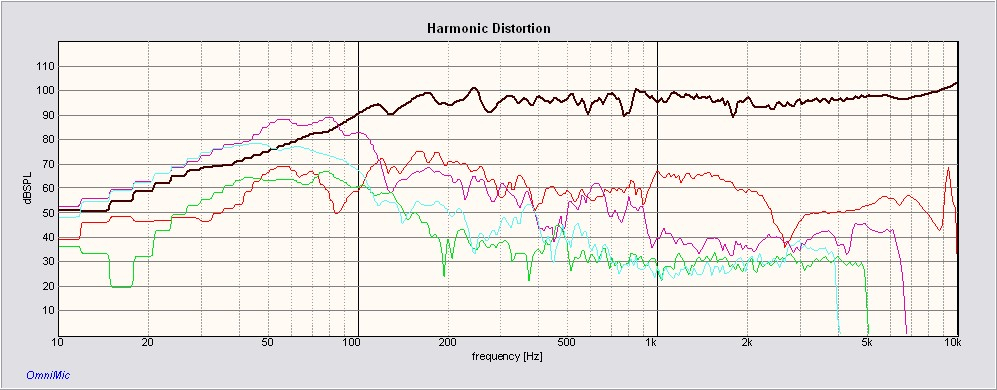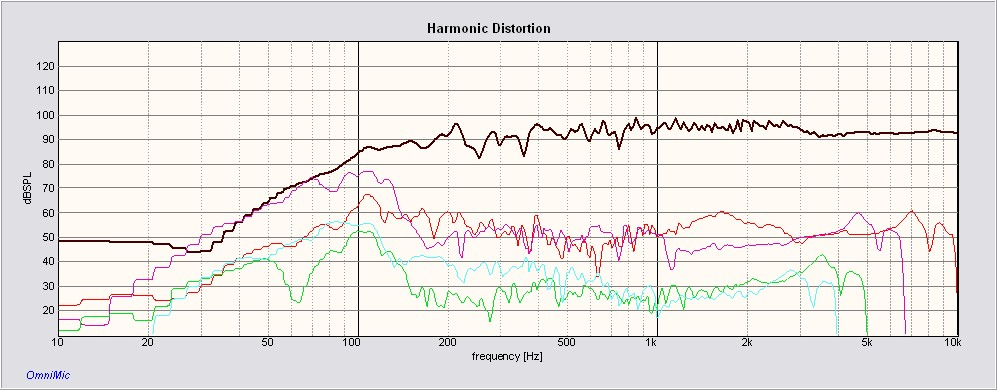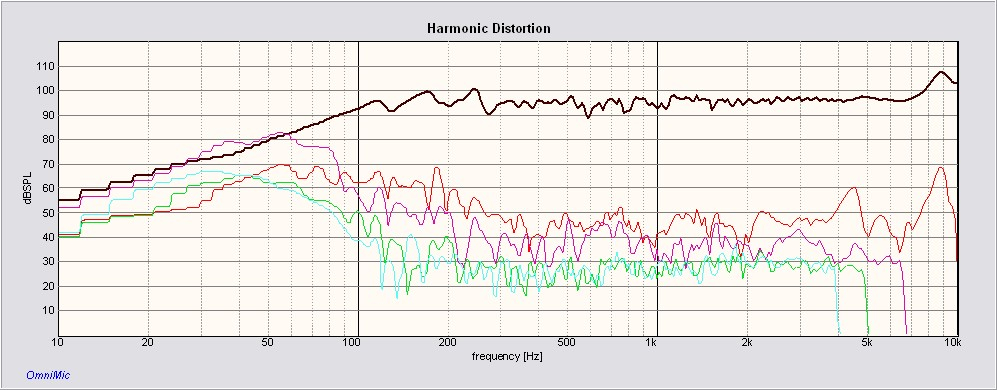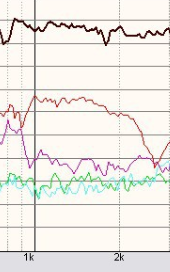Site Links
Howdy, Stranger!
It looks like you're new here. If you want to get involved, click one of these buttons!
Quick Links
Categories
In this Discussion
Who's Online (0)
Isobaric midrange
Thinking about using the pc83-8 as a midrange or desktop speaker, using it isobaric. In my mind it seems like a really good way to reduce distortion.
I have not been able to find much information on how well this would work as a midrange. It seems like it would amplify cone breakup but would reduce distortion in the frequency below the breakup.
Please post your thoughts and experiences. Thanks.
Comments
I'm trying to remember what I read about isobaric and distortion.
I think 2nd order distortion is reduced, but not 3rd order.
Could be wrong on that....
Even order distortion is reduced if the drivers are mounted opposing each other, either face to face or back to back and obviously wired out of phase. The thing that I've noticed is there seems to be less of the cabinet sound reflected back out in isobarics.
Isobaric isn't better for distortion over two drivers in parallel due to reduced cone movement.
Absolutely true but 4 times the enclosure volume.
What about 4 drivers in an MTM configuration?
The goal is to reduce midrange distortion as much as possible.
I would be interesting to compare the distortion measurements for a PC83 MTM, to a single driver like the ND91.
Ok, I've got some work to do.
John, why the ND91?
It is a similar size and uses a pretty good motor. I believe the ND91 (as opposed to the ND90) uses copper in the motor. That coupled with the neo magnet design generally yields very low distortion. Pity they are so ass ugly.
What JR said, ND91 https://www.daytonaudio.com/product/1046/nd91-4-3-1-2-aluminum-cone-full-range-driver-4-ohm
Thinking about the best way to measure for these experiments making an IEC baffle would be a big pain in the butt.
Would a cubic foot box be a more manageable solution? This could be a valuable tool for TS parameters as well.
Use the golden ratio to offset the drivers?
Have any of you made a IEC baffle? How do you store it when not in use?
Ben Cooper made one. He used large roundovers off the edges, and placed a hinge half way at the exchangeable baffle. It sits on a metal castered rack that he rolls away when not in use.
InDIYana Event Website
Build it.
https://www.jfcomponents.com/
IEC baffle folded in half would still be the size of a large door. Even if it broke down into quarters it would be large. Might be doable...
I don't have a photo, sorry. The piano style half hinge facilitated the baffle mounting, and was along the length.
Yes, it is about the size of a door, or a little bigger.
My advice, use plywood because MDF made the hinged portion very heavy.
InDIYana Event Website
I made a facsimile out of cardboard and taped it to a drywall opening in my house.
Ken, just in case you don't have the dimensions, see post #2 here. The test baffle for 8" drivers and smaller isn't that bad. 1/2" particle board with some baracing on the back, with cardboard or foamboard "wings" wouldn't be that heavy.
https://www.diyaudio.com/community/threads/how-do-dayton-vifa-mcm-measure-drivers.127706/
I made one a few years back. But you are not going to like it. It is gigantic. 52.5 x 64 inches!!! When not in use, I remove the large foam core section and store it against a wall in my upper loft. Since it is constructed mainly from 3/16" thick reinforced foam core, it is very light weight and easy to set up and break down. It mounts directly to my DIY turntable. I can manually rotate the entire IEC baffle 360 degrees in 7.5 degree increments. It has several 5.25 x 5.25" removable inserts for flush mounting tweeters and several 9.5 x 9" removable inserts for flush mounting mids or woofers up to 8" in diameter. My microphone stays in a fixed position about 60" above the floor and at a distance of about 1 meter or so for all measurements. Here are a few pics of this monster:
I had one for years. Made mine out of 5/8" OSB. I ended up throwing mine away last fall as I hadn't used it for a couple years. I just do all my measurements in box now.
I had thought for years of building one, but storage was a deal breaker. I know someone with an IEC baffle, though.
On topic, I think an isobaric mid would be a great experiment.
That last point makes a lot of sense too, just picturing that the acoustic energy has to pass into/through the interior cone, into the chamber between the drivers, and then again into/through the exterior cone to escape.
Since I'm just looking for comparative data I think I'll start with the 1cf box. I'll try some wings/round overs to make sure it has a smooth response.
Time to start cutting
That has always been my impression of isobariks as well. The inner woofer tends to isolate the outer woofer from internal box resonances. You also must consider the spacing distance between the two woofers and the frequency at which the two drivers are 180 degrees out of phase. You need to take measurements of single woofer verses isobarik to see how this cancellation affects the on-axis response.
Hello,
I've tested the PC83-8. I had posted the results to a thread on PE called "driver testing" with many other small drivers. A snippet of the PC68-8 below:

In my opinion the PC68 and particularly the PC105 is superior.
The PC68-4:

And the PC105-8:

I'm a big fan of the PC105's performance, especially given its cost.
I may have an interesting or unique take on IB driver testing as well; my experience is that it is not required for HD testing. I created a 4'x4' test baffle similar to Timothy Feleppa's test rig. It proved useful for determining my own FR measurements, but did not seem to make a significant difference in my HD testing. Recently I've taken to just running HD sweeps with little to no baffle, and my take is that the HD results are just as meaningful and only minimally less than perfect.
In general, I think a lot is made of setups with perfect measurement techniques and best practices, while very simple, crude, and quick sweeps can be very telling. Understanding the limitations of the setup is crucial though, with an eye to relative comparisons rather than absolutes.
Cheers,
Greg
Pretty sure I tested the 83-4 for the Pueveyor....
InDIYana Event Website
I just realized I had a typo above.
The first plot is the PC83-8 (mentioned as being considered), not the PC68-4 as shown in the second plot.
Greg, thank you for posting that information. PC105-8 does look like a better option for my testing. You may have also helped me confirm one of the suspicions I have about how we react to distortion.
I have wondered about the effects of distortion response. In the PC83-8 measurements, there is a pretty significant distortion anomaly in the 1k-2k range. If it were not for that anomaly would you have perceived it as just another in the lineup rather than a lesser performer? The standout PC105 does have the smoothest distortion plots.
PC83-8 anomaly

Some years ago, I adopted Troel's observation that 2nd order distortion is mostly not a problem.
The 3rd order in the PC83 600-900Hz would not be pleasant.
I don't think I'm an expert, or even have the breadth of experience of some of those here, but I also focus on HD3 and HD5 primarily.
For a midrange I would look as low as 250-300Hz.
The PC83-8's HD3 at 250-300Hz is only -30dB down.
The PC68-4's HD3 at 250-300Hz is more like -40dB down.
The PC105-8's HD3 at 250-300Hz is closer to -50dB down.
There may also be something to the idea that better HD plots are smoother HD plots, with no abrupt jumps or changes in HD across the bandwidth. For instance, the Peerless TG9FD10 has a very smooth HD plot and is regarded very highly. In this sense, the PC68-4 & PC105-8's plots are more favorable than the P83-8's.
I think there is also enough anecdotal experience to show that HD plots are only one tool to how a driver will sound.